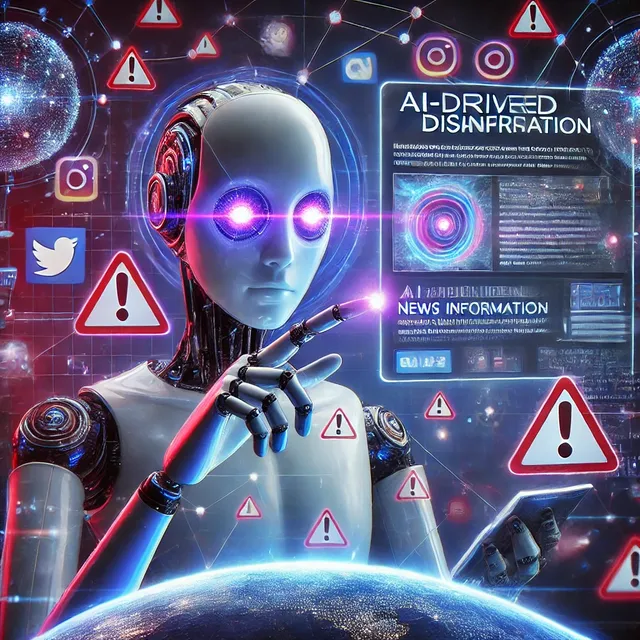⚠️ How to Prevent the Misuse of AI in Disinformation

ENGLISH VERSION:
⚠️ How to Prevent the Misuse of AI in Disinformation
Artificial intelligence (AI) has radically transformed the way we consume and share information. However, its use also presents significant challenges, particularly in the fight against disinformation. Technologies such as deepfakes, bots, and dissemination algorithms can be exploited to manipulate public opinion and spread false information on a large scale. To mitigate these risks, it is essential to adopt effective strategies that limit the misuse of AI in this context.
🔎 The Role of AI in the Spread of Disinformation
AI enables the creation of highly realistic texts, images, and videos, making it increasingly difficult to detect falsified content. Deepfakes can fabricate statements from public figures, while bots amplify fake news on social media, influencing perceptions and political decisions. The advancement of these technologies demands a strong response to ensure the integrity of online information.
👉 Strategies to Combat AI-Generated Disinformation
📊 Media Literacy and Critical Thinking
- Promote digital literacy to equip users with the skills to identify and question manipulated content.
- Encourage fact-checking and source verification before sharing information.
🔒 Strengthening Security on Digital Platforms
- Implementation of strict policies by social networks and news outlets to reduce the spread of false content.
- Development and deployment of AI systems capable of detecting deepfakes and inauthentic bot behavior in real-time.
🌐 Enhancing Fact-Checking Tools
- Use of advanced algorithms to identify distortions and inconsistencies in texts, images, and videos.
- Expansion of access to reliable fact-checking platforms for the general public.
⚖️ AI Regulation and Transparency
- Creation and enforcement of regulations that hold individuals and organizations accountable for the misuse of AI in disinformation.
- Greater transparency requirements in the development and application of AI models to prevent abuses and malicious manipulations.
🚀 Conclusion
AI represents a major advancement in communication, but its improper use can undermine trust in information. Combating AI-driven disinformation requires a coordinated effort between governments, businesses, and civil society. A combination of digital education, effective regulation, and technological innovation can ensure a safer and more reliable information environment, protecting the integrity of shared knowledge online. 🌟
GERMAN VERSION:
⚠️ Wie man den Missbrauch von KI zur Verbreitung von Desinformation verhindert
Künstliche Intelligenz (KI) hat die Art und Weise, wie wir Informationen konsumieren und teilen, radikal verändert. Ihr Einsatz bringt jedoch auch erhebliche Herausforderungen mit sich, insbesondere im Kampf gegen Desinformation. Technologien wie Deepfakes, Bots und Verbreitungsalgorithmen können genutzt werden, um die öffentliche Meinung zu manipulieren und falsche Informationen in großem Maßstab zu verbreiten. Um diese Risiken zu minimieren, ist es entscheidend, wirksame Strategien zu entwickeln, die den Missbrauch von KI in diesem Kontext einschränken.
🔎 Die Rolle der KI bei der Verbreitung von Desinformation
KI ermöglicht die Erstellung hochrealistischer Texte, Bilder und Videos, wodurch es immer schwieriger wird, gefälschte Inhalte zu erkennen. Deepfakes können falsche Aussagen öffentlicher Persönlichkeiten erzeugen, während Bots Fake News in sozialen Netzwerken verbreiten und so Wahrnehmungen und politische Entscheidungen beeinflussen. Der Fortschritt dieser Technologien erfordert eine entschlossene Reaktion, um die Integrität von Online-Informationen zu gewährleisten.
👉 Strategien zur Bekämpfung von KI-generierter Desinformation
📊 Medienkompetenz und kritisches Denken
Förderung der digitalen Bildung, damit Nutzer manipulierte Inhalte besser erkennen und hinterfragen können.
Ermutigung zur Überprüfung von Fakten und Quellen, bevor Informationen weitergegeben werden.
🔒 Stärkung der Sicherheit auf digitalen Plattformen
Einführung strenger Richtlinien durch soziale Netzwerke und Nachrichtenseiten zur Eindämmung der Verbreitung falscher Inhalte.
Entwicklung und Einsatz von KI-Systemen, die Deepfakes und unauthentisches Bot-Verhalten in Echtzeit erkennen können.
🌐 Verbesserung von Faktenprüfungs-Tools
Nutzung fortschrittlicher Algorithmen zur Identifizierung von Verzerrungen und Unstimmigkeiten in Texten, Bildern und Videos.
Erhöhung des Zugangs zu vertrauenswürdigen Faktenprüfungsplattformen für die breite Öffentlichkeit.
⚖️ Regulierung und Transparenz in der KI
Schaffung und Durchsetzung von Vorschriften, die Einzelpersonen und Organisationen für den Missbrauch von KI zur Desinformation zur Rechenschaft ziehen.
Höhere Transparenzanforderungen bei der Entwicklung und Anwendung von KI-Modellen, um Missbrauch und böswillige Manipulationen zu verhindern.
🚀 Fazit
KI ist ein bedeutender Fortschritt in der Kommunikation, doch ihr unsachgemäßer Einsatz kann das Vertrauen in Informationen untergraben. Die Bekämpfung von KI-gestützter Desinformation erfordert eine koordinierte Anstrengung von Regierungen, Unternehmen und der Zivilgesellschaft. Eine Kombination aus digitaler Bildung, wirksamer Regulierung und technologischer Innovation kann eine sicherere und vertrauenswürdigere Informationsumgebung schaffen und so die Integrität des geteilten Wissens im Internet schützen. 🌟
Upvoted! Thank you for supporting witness @jswit.